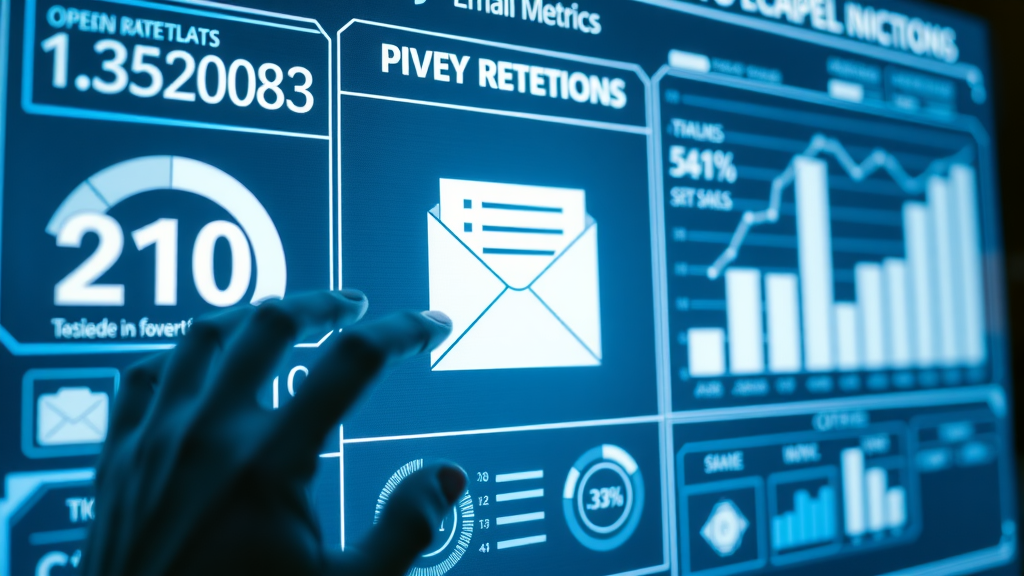Did you know that marketers who leverage email marketing analytics are 2.5 times more likely to achieve higher ROI from their campaigns? In a world flooded with digital messages, understanding how your emails perform isn’t just a nice-to-have—it’s a game-changer for your marketing strategy. This guide demystifies the power of data-driven email marketing, showing you how to decode metrics, interpret results, and transform your campaigns for measurable growth .
What You'll Learn
- Gain actionable skills in decoding email marketing analytics.
- Discover advanced strategies within email metrics.
- Understand key performance indicators and learn to optimize every email campaign for superior results.
Unlocking the Power of Email Marketing Analytics: Transform Your Campaigns Using Data
Email marketing analytics give marketers a new level of clarity, revealing precisely what works and what doesn’t in every email campaign. By harnessing a wealth of data points—such as open rate, click-through rate, conversion metrics, and bounce rate—you gain a sharp edge in creating email campaigns that resonate, engage, and convert. Imagine having the ability to tweak your subject lines, audience segments, or call-to-action placements based on real-time feedback. With access to smart analytics platforms, these transformations are not only possible but easily achievable within your marketing workflow.
A practical example: If your open rates lag industry averages, analytics can pinpoint if low engagement stems from subject line performance or delivery timing. Conversely, high open but low click-through rates indicate the content or calls to action may need attention. Using benchmarks and trend analysis ensures your campaigns are tapping into what subscribers actually want—driving both short-term engagement and sustainable list growth.

Understanding Email Marketing Analytics: What Every Marketer Should Know
Email Marketing Analytics Defined: Foundation for Data-Driven Email Marketing
At its core, email marketing analytics is the systematic approach of gathering, measuring, and interpreting data from all of your email campaigns. These analytics go far beyond just tracking who opens your emails—they reveal how subscribers interact with your messages, which links generate the most clicks, and how many recipients ultimately convert. By leveraging comprehensive email metrics , marketers can move from guesswork to strategy, ensuring every decision is backed by hard evidence.
For example, keeping a watchful eye on your campaign’s open rate and click-through rate allows you to gauge both initial interest and deeper engagement. Meanwhile, metrics like conversion rate and unsubscribe rate offer vital clues into how well your content resonates with your audience, flagging areas for improvement or successful tactics to double down on.
Why Email Marketing Analytics Drives Growth in Modern Email Campaigns
Email marketing analytics are instrumental for business growth, both in terms of revenue and audience reach. Analyzing email metrics helps marketers optimize every stage of the subscriber journey—from the first welcome message to the final purchase or sign-up. By spotting trends and understanding what truly captivates your audience, you can refine messaging, content, and design to better connect with your subscribers.
Furthermore, using data to segment your email list enables highly targeted messaging, which inevitably boosts impact and ROI. As digital competition increases, brands that prioritize and act upon their analytics consistently outperform those who leave campaign success to chance.
"Marketers who prioritize email marketing analytics are 2.5 times more likely to see higher ROI in their campaigns." — DMA Research
Core Email Metrics: What to Track and Why It Matters

Open Rate: The First Signal of Engagement in Email Marketing Analytics
The open rate is one of the most widely referenced email metrics. It measures the percentage of subscribers who opened your message compared to the total emails delivered (excluding hard and soft bounces). While it’s a key indicator of subject line performance and sender reputation, it’s not flawless—sometimes automated previews or privacy settings may inflate numbers. Still, monitoring open rates can help marketers experiment with subject lines, sending times, and preview text for stronger first impressions. A consistently high open rate signals that your audience anticipates and values your content, laying the groundwork for further action.
Click-Through Rate (CTR): Gauging Content Effectiveness With Key Email Metrics
The click-through rate (CTR) shows the percentage of recipients who clicked one or more links within an email. Unlike open rate, CTR provides deeper insight into content relevancy and the effectiveness of your calls to action. If open rates are healthy but CTR is low, it could point to issues with email design, link placement, or content clarity.
Optimizing for higher CTR means more than adding clickable buttons; it’s about presenting the right offer, in the right place, to the right audience. By closely tracking this metric, you ensure that the journey from email open to desired action becomes seamless and compelling—a vital step for boosting conversions and ROI.
Conversion Rate: The Ultimate Indicator of Successful Email Marketing Campaigns
Conversion rate represents the percentage of email recipients who completed a defined goal—making a purchase, downloading a resource, or signing up for an event—after clicking through your email. This metric is arguably the most critical for evaluating real success, as it directly connects your email marketing efforts to tangible business outcomes.
Monitoring conversion rate for each campaign helps identify which segments, messages, and offers deliver the best ROI. It allows for iterative improvements: you can optimize subject lines to increase opens, test copy and design for better clicks, and refine landing pages to boost conversions.
Bounce Rate: Monitoring Email Deliverability and List Quality
The bounce rate tracks the percentage of emails that could not be delivered to a recipient’s inbox—either returning as a hard bounce or a soft bounce . A high bounce rate can indicate issues with email list hygiene, outdated email addresses, or sender reputation, making it a pivotal yet often overlooked email metric.
Maintaining a low bounce rate ensures you’re communicating with real subscribers, helps protect sender reputation, and improves overall deliverability. Analyzing bounced email data helps marketers clean their email lists and strategize re-engagement or suppression for inactive addresses, keeping their marketing campaigns efficient and results-driven.
Unsubscribe Rate & Spam Complaint Rate: Protecting Your Email List Health
A close eye on unsubscribe rate and spam complaint rate offers a health check for audience satisfaction and list quality. If too many subscribers opt out or mark your emails as spam, this directly affects future delivery and your brand’s reputation.
Mitigating high unsubscribe or spam complaint rates often requires adjusting frequency, refining content, or improving segmentation. These actionable signals guide you in maintaining an engaged and compliant email list—essential for sustainable list growth and better performance metrics.
| Email Metric | Definition | Calculation Formula | Industry Benchmark |
|---|---|---|---|
| Open Rate | % of delivered emails that are opened by recipients. | Open Rate = (Opens ÷ Emails Delivered) × 100 | 15%–25% (varies by industry) |
| Click-Through Rate (CTR) | % of recipients who click on a link in the email. | CTR = (Clicks ÷ Emails Delivered) × 100 | 2%–5% |
| Conversion Rate | % of recipients who complete a desired action. | Conversion Rate = (Conversions ÷ Total Clicks) × 100 | 1%–3% |
| Bounce Rate | % of sent emails that cannot be delivered. | Bounce Rate = (Bounces ÷ Emails Sent) × 100 | <2% |
| Unsubscribe Rate | % of recipients who opt out of future emails. | Unsubscribe Rate = (Unsubscribes ÷ Emails Delivered) × 100 | <0.2% |
| Spam Complaint Rate | % of recipients who mark your email as spam. | Spam Complaint Rate = (Spam Complaints ÷ Emails Delivered) × 100 | <0.1% |
How to Analyze and Interpret Email Marketing Analytics for Growth
Setting Benchmarks: Understand Industry Averages for Every Email Metric
Setting clear benchmarks is crucial to determine if your email campaigns are underperforming or exceeding expectations. Industry averages—for open rate, CTR, bounce rate, and conversion rate—provide a starting point for effective goal setting. Regular benchmarking enables you to compare your current performance with competitors and peers in your segment.
For instance, if your bounce rate is double the industry average, this could highlight a problem with your email list or sender reputation. Comparing your work with established standards helps prioritize improvements, allocate resources, and celebrate wins.

Identifying Trends in Email Performance: From Open Rate to Conversion
Truly effective email strategy goes beyond isolated campaign snapshots; it demands looking at performance trends over time. Consistently tracking each email metric reveals patterns—like a gradual drop in open rates that signals audience fatigue, or spikes in conversion rates following message personalization.
Spotting these trends lets you act before minor hiccups become major issues and ensures that innovations are quickly scaled across your future marketing campaigns. It also underscores which elements, from subject lines to timing, have the greatest impact on performance.
Segmenting and Personalizing Based on Email Analytics Data
Email analytics isn’t just about overall trends—it’s a goldmine for targeted improvements. By segmenting your email list based on behaviors like opens or clicks, you can create content that feels tailor-made for each group. For example, rewarding your most engaged subscribers with exclusive offers can supercharge list growth and conversions, while re-engagement campaigns can win back inactive members.
Personalization powered by analytics ensures every message reaches the right audience, at the right time, and in the right format. The more granular your data-driven strategy, the higher your email marketing ROI.
"If you can't measure it, you can't improve it." — Peter Drucker
Email Marketing Analytics in Action: Case Studies of Winning Email Campaigns

Case Study: Boosting Open Rates Through Subject Line Optimization
A SaaS brand noticed their open rates hovering below industry benchmarks. By analyzing past campaign data, they identified that concise and curiosity-driven subject lines received nearly 20% more opens. Through A/B testing new variations in real time, they elevated their open rate from 17% to 28% within two months—simply by refining how they introduced each email.
This demonstrates how one subtle tweak, uncovered through analytics, can transform the effectiveness of an entire email campaign, making data the ultimate asset for marketers focused on growth and engagement.
Case Study: Reducing Bounce Rate and Increasing List Growth
An e-commerce business grappled with a rising hard bounce rate that threatened sender reputation. Deep analytics revealed a large segment of outdated or invalid email addresses acquired from past contests. By cleaning their subscriber database and integrating double opt-in processes, the company slashed bounce rate by 70%. At the same time, improved list hygiene contributed to higher deliverability and new subscriber trust, resulting in ongoing, sustainable list growth.
Case Study: Maximizing Conversion Rate. Lessons from High-Performing Email Marketing Campaigns
A retailer’s conversion rate plateaued at 1.1%, despite high opens and clicks. By analyzing click maps and conversion flows with advanced analytics, the team realized their CTAs were buried in dense copy. Redesigning their emails with prominent CTAs and mobile-optimized layouts, they saw immediate gains: conversion rates climbed above 2%. Data-driven design changes turned a so-so performer into a standout marketing campaign.
Addressing Deliverability: Hard Bounce, Soft Bounce, and Spam Complaints in Email Marketing Analytics
Hard Bounce vs. Soft Bounce: What Do They Mean for Email Deliverability?
A hard bounce indicates a permanent delivery failure—like sending emails to an invalid address or a domain that no longer exists. In contrast, a soft bounce results from temporary issues, such as a recipient’s mailbox being full or a temporary server glitch. Both types impact your email deliverability and sender reputation.
Addressing bounces requires regular list maintenance: promptly remove hard-bounced emails and monitor soft bounces to avoid repeated sends to problematic accounts. Clean lists and responsible sending practices are your best defense for maximizing inbox placement.

Mitigating Spam Complaints and Their Impact on Email Marketing Metrics
Spam complaints can quickly erode sender reputation, reduce deliverability, and jeopardize your marketing campaigns. Analytics platforms track complaint rates so you can respond proactively. Common causes include over-frequent emails, misleading subject lines, or unclear unsubscribe processes.
Lowering complaint rates involves segmenting your audience, personalizing content, and making Opt-out easy and transparent. Always follow best practices—never purchase lists, honor unsubscribe requests promptly, and respect privacy preferences to keep spam complaints minimal.
Practical Tips: Boost Your Email Marketing Analytics Through Strategic Tweaks

- A/B Testing Email Subject Lines for Improved Open Rates
- Optimizing CTA Placement for Increased Click-Through Rate
- Cleaning and Segmenting Your Email List
- Monitoring and Reducing Unsubscribe and Spam Complaint Rates
- Personalizing Email Content Utilizing Analytics Insights
Essential Tools and Software: Top Platforms for Email Marketing Analytics
Feature Comparison: Leading Email Marketing Analytics Platforms (Table)
| Analytics Platform | Core Analytics Features | Ease of Use | Pricing |
|---|---|---|---|
| Mailchimp | Open & Click Tracking, A/B Testing, Segmentation, AI Insights | Beginner-friendly | Free - $299/month |
| HubSpot | Behavioral Analytics, Conversion Flows, Automation | User-friendly Interface | Free - $800+/month |
| ActiveCampaign | Advanced Segmentation, Automation, Predictive Sending | Easy to Moderate | $9 - $229/month |
| Campaign Monitor | Detailed Click Maps, Engagement Scoring, Reporting | Simple Dashboard | $9 - $149/month |
| GetResponse | AB Testing, Conversion Funnels, Real-time Analytics | Intuitive | $15 - $99/month |

Using Integrations: Maximizing Email Campaign Insights with Business Intelligence Tools
Integrating email analytics with broader business intelligence (BI) tools, such as Google Analytics or Tableau, enables you to see email’s true impact within your marketing strategy. BI integrations can track the full subscriber journey—from email open to final conversion—and highlight how email supports larger business goals.
With cross-platform data, marketers can connect the dots between email campaigns , website behaviors, and offline actions, providing a 360-degree view essential for optimizing every customer touchpoint.
Advanced Strategies: Optimizing Marketing Campaigns with Comprehensive Email Marketing Analytics
Predictive Analytics and AI: The Future of Email Marketing Metrics
The next frontier in email marketing analytics is powered by predictive analytics and artificial intelligence (AI). AI-driven platforms can forecast subscriber behaviors, recommend send times, and even auto-optimize subject lines for each segment. Predictive analytics analyzes historical email metric data to anticipate future trends—helping marketers stay ahead of audience preferences and competition.
As email platforms adopt more machine learning capabilities, expect greater automation, hyper-targeting, and smarter recommendations, all guided by real-world data rather than guesswork.

Attribution: Measuring Return on Investment in Email Marketing Campaigns
It’s not enough to know how many opens or clicks you receive; you must also link email interactions to actual revenue or conversions. That’s where attribution metrics come in—they enable you to assign value to every email touchpoint along the customer journey.
Sophisticated attribution models help clarify your true return on investment (ROI), comparing email against other marketing channels and revealing the campaigns, content, and segments most responsible for driving growth.
Automated Reporting: Streamlining Email Performance Reviews
Manual data pulls and ad-hoc spreadsheets are relics of the past. Modern email marketing tools feature automated reporting, which delivers regular snapshots of campaign performance straight to your dashboard or inbox. Automated reports cover key metrics, flag performance anomalies, and visualize long-term trends at a glance.
This streamlines decision-making and keeps all team members—no matter their level of technical skill—up to date on what’s working and where to focus next.
Integrating Email Marketing Analytics Across Multichannel Marketing Campaigns
How Email Metrics Inform Broader Marketing Strategies
Email metrics don’t operate in a silo. The insights you glean from subscriber behaviors, topic interests, and conversion flows should inform your entire marketing strategy . For instance, successful subject lines can provide inspiration for social media ads, while high-performing segmented offers can be mirrored across SMS, push notifications, and retargeting efforts.
Integrating email data with other channels enables smarter budget allocation, cohesive brand messaging, and higher overall marketing ROI.

Case Example: Using Email Data to Boost Cross-Channel Conversions
A global apparel brand analyzed email click data to identify which product categories resonated most with their audience. By feeding these learnings into their Facebook and Google Ad strategies, they achieved a 40% lift in cross-channel conversions and strengthened overall campaign effectiveness.
This synergy between email analytics and other channels is the key to breaking marketing silos and amplifying results.
Key Compliance Metrics: Privacy, GDPR, and Data Security in Email Marketing Analytics
Best Practices for Data Handling and Subscriber Consent
Compliance is non-negotiable. Adhering to GDPR, CAN-SPAM, and other privacy frameworks means securing explicit subscriber consent, properly storing personal data, and honoring opt-out requests. Transparency in how you use customer data builds trust, boosts brand reputation, and prevents penalties.
Best practices include double opt-in, easily accessible privacy policies, and robust data storage protocols—each protecting both you and your subscribers.

Ensuring Compliance in Email Performance Measurement
Analytics should be configured to anonymously track performance and avoid collecting unnecessary personally identifiable information. Use data strictly for intended marketing purposes and routinely audit your analytic workflows.
This diligence ensures you stay compliant as privacy laws evolve and fosters continued trust from your growing email list community.
People Also Ask: Exploring Popular Questions in Email Marketing Analytics
What is email marketing analytics?
Email marketing analytics involves the process of collecting, measuring, and analyzing data from email campaigns to evaluate performance and guide optimizations. It focuses on metrics such as open rate, click-through rate, conversion rate, bounce rate, and more, helping marketers make data-driven decisions for email marketing success.
What does an email marketing analyst do?
An email marketing analyst is responsible for developing, tracking, and interpreting email marketing analytics to improve campaign performance. Their role includes analyzing open and click rates, segmentation results, bounce data, and conversion metrics, as well as making strategic recommendations based on the insights.
What are the 4 P's of email marketing?
The 4 P's of email marketing are Product, Place, Price, and Promotion. These elements guide the design and targeting of email marketing campaigns and are supported by analytics to improve effectiveness and ROI.
What is the 80 20 rule in email marketing?
The 80/20 rule in email marketing states that 80% of your results (e.g., engagement or conversions) often come from 20% of your subscribers. Analytics help identify this high-performing segment, allowing marketers to focus efforts for maximum impact.
Common Mistakes in Email Marketing Analytics and How to Avoid Them
Relying Solely on Open Rate: The Need for a Multi-Metric Approach
Many marketers place undue emphasis on open rate alone, but this can yield a narrow view of campaign success. Privacy features and mail client quirks may also distort this metric. Instead, adopt a holistic approach—consider CTR, conversion rate, and unsubscribe rate alongside opens to paint a true picture of engagement.
Multiple metrics together tell a richer story, driving smarter optimizations and sustainable results over time.
Ignoring List Growth and Unsubscribe Rate Signals
Don’t overlook the twin signals of list growth and unsubscribe rate. Rapid list expansion accompanied by a rising unsubscribe rate can signal poor list quality. Conversely, steady list growth is healthy—unless it’s negated by frequent opt-outs or acquisitions from dubious sources.
Balance audience acquisition with careful monitoring, ensuring you’re adding and retaining genuinely interested subscribers.
Misinterpreting Conversion and Bounce Rate Data
Conversion and bounce rates are two of the most actionable—but also most misunderstood—email metrics. Low conversions may be blamed on poor design, when in fact, a mismatch between offer and audience is to blame. Similarly, a sudden spike in bounce rate often points to an outdated email list, not technical errors.
Always analyze the context and trends behind these metrics before making major strategic shifts.
- Top Email Marketing Analytics Pitfalls and Solutions:
- Fixation on open rate → Track multiple metrics.
- Poor list hygiene → Regularly clean and validate email addresses.
- Neglecting unsubscribe and spam complaint rates → Monitor audience satisfaction closely.
- Overlooking data privacy → Always maintain regulatory compliance.
FAQs: Most Pressing Questions on Email Marketing Analytics
How often should I review email marketing analytics?
Ideally, review your email metrics after every campaign but also analyze monthly and quarterly trends for bigger-picture insights. Regular analysis ensures you stay proactive and responsive to evolving subscriber behaviors.
Which is more important, open rate or click-through rate?
While both are important, click-through rate (CTR) is often a stronger engagement indicator, as it shows subscribers are interacting with your content. Combine CTR with conversion and unsubscribe rates for well-rounded insights.
Can I improve conversion rate without higher open rates?
Yes—a compelling offer, clear CTA, and optimized landing pages can all increase conversions among those who open your emails, even if overall open rates aren’t rising.
What tools can automate email marketing analytics for beginners?
User-friendly platforms like Mailchimp, Constant Contact, and GetResponse offer automation, A/B testing, and real-time reporting, making them accessible for beginners eager to optimize their results.
Expert Perspectives: Insights from Leading Email Marketing Analytics Professionals
"The key to email marketing success is relentless testing and data-driven pivoting." — Ann Handley
"Email marketing analytics is the compass that guides your every campaign decision." — Jay Baer
Real-World Takeaways from Mastering Email Marketing Analytics
- Data illuminates high-performing email campaigns.
- Regularly track and benchmark every core email metric.
- Continual optimization leads to robust list growth and ROI.
- Integrate analytics insights into every step of your marketing workflow.
Ready to Transform Your Results? Apply Email Marketing Analytics for Sustainable Growth
Leverage the full power of email marketing analytics starting today. Put data at the heart of your strategy—track every email metric, refine every campaign, and watch your ROI soar.
 Add Row
Add Row  Add
Add 




Write A Comment